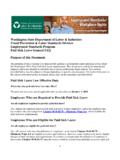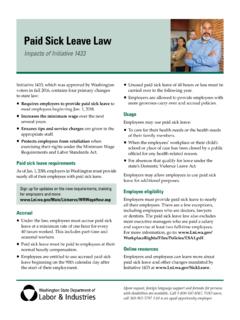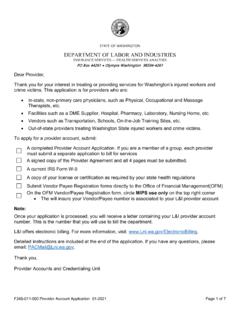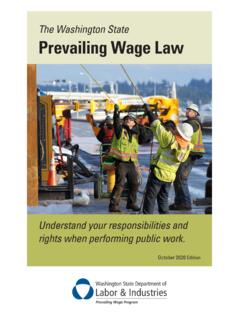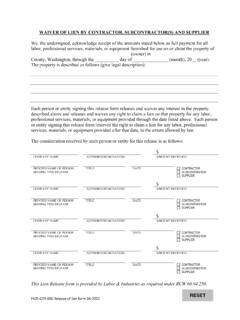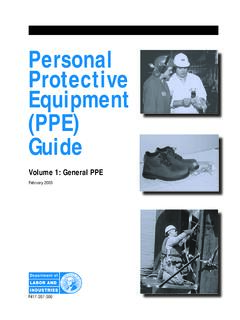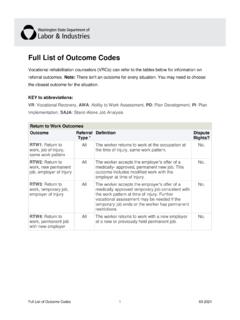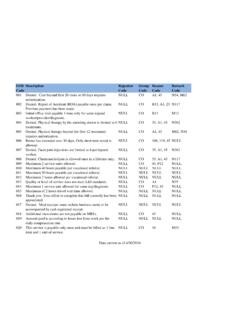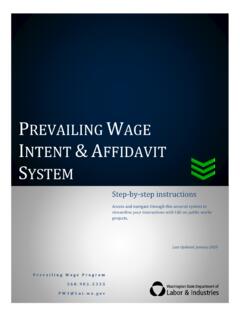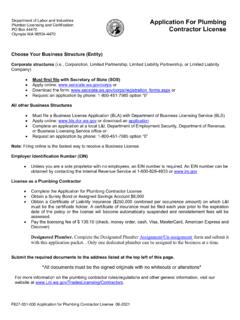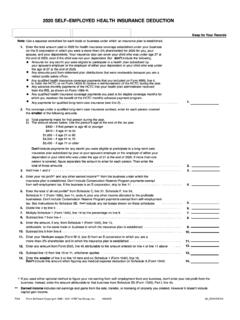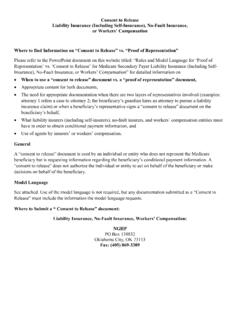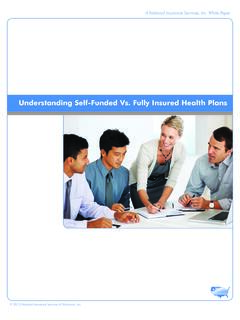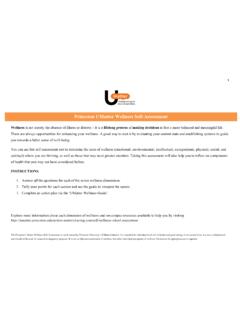Transcription of Self Insurance Claim Adjudication Guidelines
1 Medical Treatment April 2022 Page 1 of 70 Medical Treatment self - Insurance Claims Adjudication Guidelines Page Authorization and Denial of Treatment .. 5 Acupuncture .. 5 Authorization Requirements .. 5 Documentation 5 Ambulance Services .. 6 Emergency Transport .. 6 Nonemergency Transport .. 6 Amputation and 7 Prosthetics .. 7 Stump Socks and Sleeves .. 7 Additional or Backup Prosthetics .. 8 Repair and Replacement .. 8 Repairing or Replacing Prosthetics on Closed Claims .. 9 Attending Providers .. 9 Transfer of Providers .. 10 Transfer Without a Specific Request .. 10 Transfer of Attending Provider for Surgery .. 11 Required Transfer of Attending Provider .. 11 Autologous Blood Transfusions .. 12 Biofeedback .. 12 Chiropractic Treatment .. 12 Introduction .. 12 Chiropractic Scope of Practice .. 13 Chiropractic 13 Chiropractic Treatment .. 13 Chiropractic Diagnoses and Billing .. 14 Chronic Pain Management Program.
2 14 SIMP .. 14 Requirements the Worker Must Meet .. 15 Requirements the SIMP Provider Must Meet .. 15 Medical Treatment April 2022 Page 2 of 70 Phases of an approved SIMP .. 16 Evaluation Phase .. 16 Treatment Phase .. 17 Follow Up Phase .. 19 Worker Responsibilities .. 22 Vocational Services and SIMP .. 22 Return to Work Action Plan .. 23 Return to Work Action Plan Roles and Responsibilities .. 23 Concurrent Treatment .. 24 Consultations .. 25 Coverage Decisions on Medical Devices & Procedures .. 26 Dental Treatment .. 26 Authorization .. 28 General Drug Guidelines .. 28 General Principles Used to Determine Coverage .. 28 General Limitations .. 28 Outpatient Drug and Medication Decisions .. 29 Drugs with Limitations .. 29 Special Drug 30 Hearing Aids and Masking 30 Home Health and Nursing Home Services .. 31 Introduction .. 31 Home Health Care and Attendant Services .. 31 Home Health Care Definitions.
3 31 Agency .. 32 Home Health 32 Attendant Services .. 32 Homemaker or Chore Worker Services .. 34 Nursing Home, Residential, and Hospice Care Services .. 34 Independent Medical Examinations .. 35 Scheduling Independent Medical 36 Compensation for Attending an Independent Medical Examination .. 37 No-Show Fees .. 39 Infectious Diseases .. 39 Preventative Treatment .. 39 Confidentiality of Infectious Disease Records .. 39 Medical Treatment April 2022 Page 3 of 70 Injections (Therapeutic or Diagnostic) .. 40 Epidural Injection .. 40 Vertebral Facet Joint Injection .. 40 Trigger Point Injection .. 40 Dry Needling Injection .. 41 Hyaluronic Acid Injection .. 41 Chymopapain Injection .. 42 Botulinum Toxin-A Injection (Botox) .. 43 Injectables .. 43 Medical Exams Requested by 44 Medical Reports and Documentation .. 45 Reporting Requirements .. 45 Provider s Initial Report (PIR).. 45 60-day narrative report.
4 45 Office notes .. 46 Special report/follow-up report .. 46 Consultation examination report .. 46 Attending provider review of IME report .. 46 Reopening application .. 46 Ancillary provider reports .. 46 Activity Prescription Form (APF) .. 47 When the AP Does Not Cooperate .. 47 Report Content SOAPER .. 47 Reviewing Medical 49 Components of a Medical Chart .. 49 Employer Requests for Return to Work Information .. 50 Obtaining Prior Medical Records .. 50 Newly Contended or Unrelated Medical Conditions .. 51 Contention of a New Condition .. 51 Conditions Resulting from Treatment for the Industrial Injury or Occupational 51 Segregation of an Unrelated Condition .. 52 Temporary Treatment of Conditions Delaying Recovery .. 52 Authorizing Temporary Treatment .. 53 Obesity Treatment Programs .. 53 Obesity Treatment Requests .. 54 Obesity Treatment Not Payable .. 55 Obesity Treatment 56 Payment of Medical Bills.
5 57 Adjudication of Bills .. 57 Out of State Providers .. 57 Medical Treatment April 2022 Page 4 of 70 Bills Paid by the Worker or Another Party .. 58 Rejected and Closed Claims .. 58 Physical Medicine .. 59 Massage Therapy .. 59 Physical 59 Occupational Therapy .. 60 Work Conditioning .. 60 Work Hardening .. 61 Functional Capacity Evaluation .. 61 Mental Health Treatment .. 61 Who Can Treat .. 62 Authorizing a Mental Health Evaluation .. 63 American Psychiatric Association DSM-5 Manual .. 63 Mental Health Services .. 64 Mental Health Confidentiality Requirements .. 62 Revealing of Mental Health Conditions or Treatment .. 62 Specialized Equipment .. 66 Surgery .. 67 Surgery Authorization Requests .. 67 Consultations for Second Opinions .. 67 Surgery for Preexisting Conditions Aggravated by the Industrial Injury or Disease .. 68 Tobacco Cessation .. 68 Treatment During Protest or Appeal .. 69 Treatment Not Authorized.
6 69 Treatment on Pension Cases .. 70 Medical Treatment April 2022 Page 5 of 70 Authorization and Denial of Treatment WAC 296-15-425 For all treatment requiring authorization under WAC 296-20-03001, self -insurers must notify the worker in writing within five days of the decision to authorize or deny the requested treatment. This notification must be provided using the Treatment Decision template (form F207-226-000). Acupuncture WAC 296-23-238 Authorization Requirements Effective June 1, 2019, acupuncture may be authorized for low back pain when related to an accepted condition on a Claim . Acupuncture should not be covered for treatment of any other conditions. Prior authorization is not required for acupuncture treatment, but treatment should only be covered if the referral is made by the attending provider. Up to 10 acupuncture visits may be covered over the lifetime of the Claim . Treatment should be provided with a licensed Acupuncturist, also called an East Asian Medicine Practitioner.
7 Documentation Requirements For continued authorization to be provided, there must be documented improvement in the worker s function over the course of treatment. The Oswestry Disability Index (ODI) and 2-item Graded Chronic Pain Scale (GCPS) functional scores must be used to assess the worker s improvement in pain and function at baseline, middle/fifth visit, and at treatment end. All reports should include the following information: Summary of subjective complaints. Objective findings. Treatment plan focusing on functional improvement. The final visit report must also include the reason for discharge. Medical Treatment April 2022 Page 6 of 70 Ambulance Services RCW (1) Emergency Transport Ambulance services are paid when a worker s injury is so serious that the use of any other method of transportation is contraindicated. The insurer pays for ambulance services to the nearest place of proper treatment.
8 The facility must be generally equipped to provide the needed medical care. A facility is not considered a place of proper treatment if no bed is available when inpatient medical services are required. Air ambulance services, either by helicopter or fixed wing aircraft, are paid only if: The worker s medical condition requires immediate and rapid ambulance transportation that could not have been provided by ground ambulance, or The point of pickup is inaccessible by ground vehicle, or Great distances or other obstacles are involved in getting the worker to the nearest place of proper treatment. Nonemergency Transport Only medical providers may arrange for nonemergency ambulance transportation. Workers may not arrange nonemergency ambulance transportation. Nonemergency transport by ambulance is appropriate if: The worker is bed-confined, and it is documented that the worker s accepted medical condition is such that other methods of transportation are contraindicated.
9 Bed-confined means the worker is unable to: o Get up from bed without assistance, o Ambulate, or o Sit in a chair or wheelchair The worker s accepted medical condition, regardless of bed confinement, is such that transportation by ambulance is medically required. An ambulance can also be used to transport workers to: Another facility for treatment. Medical Treatment April 2022 Page 7 of 70 Their own city if injured and treated in another city. Scheduled, regularly-provided diagnostics or treatment. An independent medical examination or a consultation. Payment is made in accordance with the appropriate fee schedule. Amputation and Prosthetics RCW , WAC 296-20-1102 The insurer will authorize and pay for amputation, prosthetics, and orthotics when needed by the worker and substantiated by the attending provider. The provider must obtain prior authorization, and the amputation, prosthetics, and orthotics must be appropriate and medically necessary to treat the worker s accepted condition.
10 There are three types of claims involving amputation and prosthetics: A traumatic amputation, where a catastrophic incident either caused or necessitated the amputation of a limb or appendage. An amputation as a result of complications of the injury or occupational disease itself or from complications caused by preexisting or unrelated illness. An injury that caused damage to an artificial limb. (Once the repair/replacement is completed and certified by the attending provider as acceptable, no additional prosthetic services should be allowed under the Claim .) Prosthetics With any amputation, there will be post-operative casting applied to the remaining portion of the limb (stump). The initial prosthesis is a temporary one and will last from three to nine months. Each replacement will last about twice as long as the previous replacement, up to a long-term replacement every three to five years. Although stump shrinkage may occur at any time, the majority of shrinking will occur during the first three to nine months.
